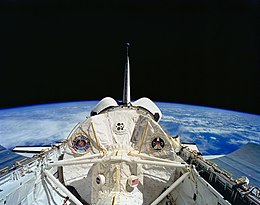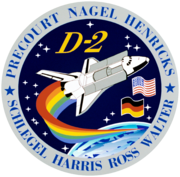STS-55

Spacelab in Columbia's payload bay
|
|
| Mission type | Research |
|---|---|
| Operator | NASA |
| COSPAR ID | 1993-027A |
| SATCAT no. | 22640 |
| Mission duration | 9 days, 23 hours, 39 minutes, 59 seconds |
| Distance travelled | 6,701,603 kilometers (4,164,183 mi) |
| Orbits completed | 160 |
| Spacecraft properties | |
| Spacecraft | Space Shuttle Columbia |
| Landing mass | 103,191 kilograms (227,497 lb) |
| Payload mass | 11,539 kilograms (25,439 lb) |
| Crew | |
| Crew size | 7 |
| Members |
Steven R. Nagel Terence T. Henricks Jerry L. Ross Charles J. Precourt Bernard A. Harris, Jr. Ulrich Walter Hans Schlegel |
| Start of mission | |
| Launch date | 26 April 1993, 14:50 UTC |
| Launch site | Kennedy LC-39A |
| End of mission | |
| Landing date | 6 May 1993, 14:30 UTC |
| Landing site | Edwards Runway 22 |
| Orbital parameters | |
| Reference system | Geocentric |
| Regime | Low Earth |
| Perigee | 304 kilometres (189 mi) |
| Apogee | 312 kilometres (194 mi) |
| Inclination | 28.45 degrees |
| Period | 90.7 min |
 Left to right - Seated: Henricks, Nagel, Precourt; Standing: Harris, Schlegel, Ross, Walter |
|
STS-55 (Space Transportation System 55), or D-2 was the 55th overall flight of the US Space Shuttle and the 14th flight of Shuttle Columbia. This flight was a multinational Spacelab flight involving 88 experiments from eleven different nations. The experiments ranged from biology sciences to simple earth observations.
Columbia carried to orbit the second reusable German Spacelab on the STS-55 mission and demonstrated the shuttle's ability for international cooperation, exploration, and scientific research in space. The Spacelab Module and an exterior experiment support structure contained in Columbia’s payload bay comprised the Spacelab D-2 payload. (The first German Spacelab flight, D-1, flew Shuttle mission 61-A in October 1985.) The U.S. and Germany gained valuable experience for future space station operations.
The D-2 mission, as it was commonly called, augmented the German microgravity research program started by the D-1 mission. The German Aerospace Research Establishment (DLR) had been tasked by the German Space Agency (DARA) to conduct the second mission. DLR, NASA, the European Space Agency (ESA), and agencies in France and Japan contributed to D-2's scientific program. Eleven nations participated in the experiments. Of the 88 experiments conducted on the D-2 mission, four were sponsored by NASA.
The crew worked in two shifts around-the-clock to complete investigations into the areas of fluid physics, materials sciences, life sciences, biological sciences, technology, Earth observations, atmospheric physics, and astronomy. Many of the experiments advanced the research of the D-1 mission by conducting similar tests, using upgraded processing hardware, or implementing methods that took full advantage of the technical advancements since 1985. The D-2 mission also contained several new experiments which were not previously flown on the D-1 mission.
The mission surpassed the 365th day in space for the Space Shuttle fleet and the 100th day of flight time in space for Columbia, the fleet's oldest Orbiter, on its fourteenth flight.
...
Wikipedia

